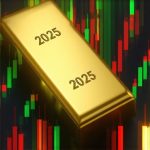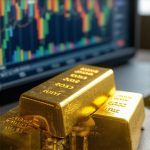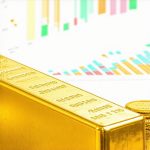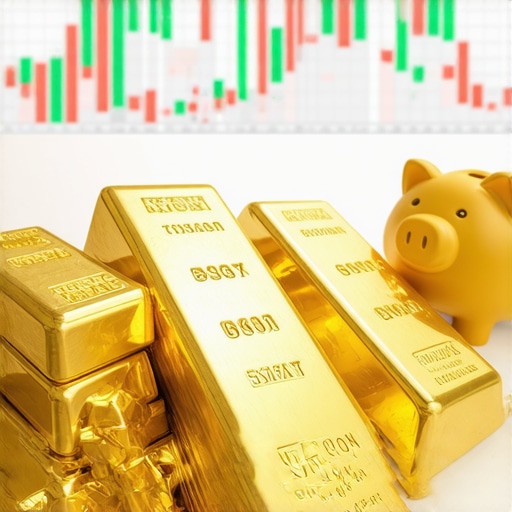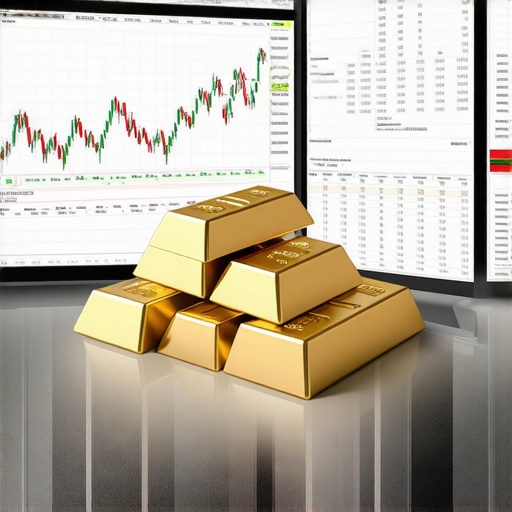Golden Opportunities: Why 2025 Is Your Year to Shine in Gold ETFs
Picture this: you’re at a bustling café, overhearing a lively debate about the best hedge against economic uncertainty. Stocks? Bonds? Nah, the buzz is all about gold ETFs — those shiny, digital gateways to the age-old allure of gold. But how exactly do you build a balanced portfolio that taps into this gleaming potential without turning your investment into fool’s gold? Let’s dive into the art and science of crafting a gold ETF portfolio primed for 2025 growth.
Mixing the Metals: Diversification Within Gold ETFs
First off, balance isn’t just a buzzword; it’s the bedrock of any resilient portfolio. Gold ETFs come in various flavors — from those tracking physical gold bullion to funds investing in gold mining companies. By combining different types, you reduce risk exposure while capturing upside from multiple angles. For instance, pairing a stable, physical gold-backed ETF with a more volatile but potentially lucrative gold mining ETF can sweeten returns while cushioning against market swings.
Is It Just About the Shine, or Does Strategy Trump Sparkle?
Investors often ask: should I chase the glittering promise of high returns, or play it safe with steady growth? The truth lies somewhere in between. Allocating a portion of your portfolio to ETFs focused on established gold producers ensures stability, while a slice aimed at junior miners or thematic funds can inject growth potential. Remember, the gold market is influenced by factors like central bank purchases, geopolitical tensions, and inflation fears — so a nimble strategy that adapts to these trends is your best bet. For a deeper dive into how central bank moves sway gold prices, the Investopedia analysis offers invaluable insights.
Timing the Tides: When to Buy and How Much?
Building a balanced gold ETF portfolio isn’t about throwing all your savings in at once. Dollar-cost averaging, a tried-and-true technique, allows you to smooth out volatility by investing fixed amounts regularly. This method is especially pertinent given gold’s market dynamics in 2025, influenced by inflation and global economic shifts. Moreover, monitoring key trends and expert predictions, like those discussed in gold price forecasts for 2025, can help you time your purchases more strategically.
Rethinking Risk: How Much Gold Should You Really Hold?
Conventional wisdom suggests 10-15% allocation to gold as a hedge, but savvy investors might tweak this based on their risk appetite and market outlook. In volatile times, a heftier gold ETF slice can provide a protective glow, while in bullish equity markets, dialing it down could free up capital for growth. The key is flexibility — your portfolio should reflect your personal financial goals and tolerance for market gyrations.
Feeling inspired to craft your own glittering gold strategy? Share your thoughts or questions below — let’s keep the conversation sparkling! And if you’re curious about top gold ETFs and mutual funds poised for 2025 growth, check out this comprehensive guide to get started.
Balancing Act: Integrating Gold ETFs with Broader Investment Portfolios
In today’s complex financial landscape, savvy investors recognize that gold ETFs should not operate in isolation. Instead, they serve as a dynamic component within a diversified portfolio that includes equities, bonds, and alternative assets. This integration helps mitigate systemic risks while leveraging gold’s unique properties as a safe haven during market turbulence and inflationary pressures. For instance, pairing gold ETFs with inflation-protected securities or dividend-paying stocks can enhance portfolio resilience and income potential simultaneously.
How Can Emerging Global Trends Shape Gold ETF Performance in 2025?
As global economic power shifts and geopolitical uncertainties persist, several emerging trends warrant close attention. Central bank policies remain pivotal: increased gold purchases by emerging markets can tighten supply and push prices higher, while monetary easing in developed economies may spur inflation fears, boosting gold demand as a hedge. Technological advances in mining and ESG (environmental, social, and governance) considerations also influence gold mining ETFs’ attractiveness, as investors increasingly prioritize sustainability in their portfolios.
Moreover, the rise of digital currencies and blockchain-based gold tokens introduces new dimensions to gold investment strategies, blending traditional and innovative approaches. Staying informed about these evolving factors can empower investors to adjust their gold ETF allocations proactively.
According to the World Gold Council’s latest report (World Gold Council, 2024), demand for gold in investment products is expected to remain robust amid ongoing economic uncertainty, reinforcing gold’s role as a portfolio cornerstone.
Strategizing Entry and Exit Points: Leveraging Market Analysis for Gold ETFs
Timing remains a nuanced but critical element for maximizing returns in gold ETFs. Beyond dollar-cost averaging, advanced investors incorporate technical analysis, macroeconomic indicators, and sentiment data to identify optimal buying and selling windows. For example, monitoring real interest rates, currency fluctuations, and geopolitical risk indices can illuminate periods when gold is undervalued or poised for rallies.
Additionally, staying attuned to quarterly earnings and operational updates from gold mining companies underlying certain ETFs can offer insights into potential fund performance shifts. Combining these quantitative and qualitative analyses helps refine portfolio adjustments aligned with market cycles.
Mitigating Risks: Managing Volatility and Fees in Gold ETF Investments
While gold ETFs provide access to gold’s benefits, investors must be vigilant about associated risks and fees. Expense ratios, liquidity constraints, and tracking errors can erode returns if not managed carefully. Choosing ETFs with transparent fee structures and robust liquidity profiles is essential. Furthermore, understanding the nuances between physical gold-backed ETFs and those invested in mining stocks aids in risk calibration, as mining ETFs typically entail higher volatility but may offer greater growth potential.
For those seeking to deepen their expertise, exploring proven gold trading techniques can complement ETF strategies by enhancing timing and diversification skills.
What strategies have you found most effective when balancing risk and reward in your gold ETF portfolio? Share your experiences and insights in the comments below — your contribution enriches our community’s collective wisdom. Interested in expanding your knowledge? Explore our best gold ETFs and mutual funds for stable income to discover curated options for 2025 and beyond.
Synergizing Gold ETFs with Alternative Assets: Unlocking Hidden Portfolio Alpha
Beyond traditional diversification, integrating gold ETFs with alternative investments like real estate, commodities, and private equity can unveil new layers of portfolio resilience and alpha generation. Gold’s low correlation with equities and bonds makes it a natural diversifier, yet coupling it with alternatives that also react differently to macroeconomic shifts can smooth volatility and enhance returns. For instance, pairing gold ETFs with real estate investment trusts (REITs) can hedge inflation while providing income streams, creating a multi-dimensional buffer against market shocks.
However, advanced investors must navigate liquidity mismatches and differing risk profiles across these asset classes. Employing dynamic asset allocation models that incorporate machine learning or factor-based analysis can optimize these complex interactions, ensuring that gold ETFs complement rather than conflict with other holdings.
How Can Advanced Quantitative Models Enhance Gold ETF Portfolio Decisions?
Leveraging quantitative techniques such as mean-variance optimization, Monte Carlo simulations, and regime-switching models allows investors to anticipate shifts in gold market dynamics and adjust allocations proactively. For example, regime-switching frameworks can identify when gold is entering a bullish inflation-driven phase versus a risk-off safe haven phase, informing tactical overweight or underweight decisions.
Incorporating macroeconomic indicators—like real interest rates, U.S. dollar strength, and geopolitical risk indices—into these models adds predictive power. This multi-factor approach transcends simplistic heuristics, enabling more nuanced portfolio construction that aligns with evolving global conditions. Research published in the CFA Institute Journal demonstrates how such methodologies improve risk-adjusted returns in precious metals portfolios.
Decoding Market Sentiment: Behavioral Insights for Timing Gold ETF Trades
While fundamentals and quantitative models provide a solid foundation, understanding investor psychology and market sentiment can refine entry and exit strategies. Sentiment indicators derived from options markets, futures positioning, and social media analytics often presage price inflection points before traditional signals manifest.
For instance, excessive speculative net long positions in gold futures might hint at an impending price correction, signaling a prudent moment to reduce ETF exposure. Conversely, spikes in fear indices or geopolitical tensions can precede gold rallies, offering tactical buying opportunities. Integrating sentiment analysis with technical and fundamental data creates a robust, multi-layered framework for timing trades.
Advanced Risk Management: Navigating Volatility and Structural ETF Nuances
Investing in gold ETFs requires vigilance beyond headline expense ratios. Deep dive into bid-ask spreads, ETF tracking error, and underlying asset liquidity to prevent erosion of returns. Mining-focused ETFs, while growth-oriented, carry operational risks such as labor disputes, regulatory changes, and environmental liabilities that can abruptly impact valuations.
Implementing stop-loss orders, position sizing algorithms, and stress testing your portfolio under extreme market scenarios are essential risk mitigation tools. Additionally, tax implications—like the treatment of gold ETFs as collectibles in some jurisdictions—warrant strategic planning to optimize after-tax returns.
Exploring SEC guidance on ETF risks can deepen your understanding of these complexities and inform smarter investment choices.
Are you ready to elevate your gold ETF strategy with these advanced insights? Engage with our expert content and share your nuanced approaches to portfolio integration and market timing — your perspective could illuminate new pathways for fellow investors.
Decoding the Subtle Art of Gold ETF Portfolio Rebalancing
Seasoned investors know that gold ETF portfolios are not “set-and-forget” assets. The evolving macroeconomic landscape of 2025 demands periodic recalibration aligned with shifting inflation expectations, currency fluctuations, and geopolitical upheavals. Dynamic rebalancing strategies—leveraging both quantitative signals and qualitative insights—can optimize returns while mitigating drawdowns. This involves systematically adjusting allocations among physical gold ETFs, mining equities, and thematic funds in response to market regimes and central bank activity.
What Role Does Behavioral Finance Play in Timing Gold ETF Trades?
Beyond the technical and fundamental realms, behavioral finance provides a nuanced lens to anticipate investor herd behavior and sentiment-driven price swings. Gold markets often experience exuberance or unwarranted pessimism that can be exploited through contrarian positioning. Indicators such as the Commitment of Traders (COT) report, sentiment surveys, and social media analytics reveal crowd psychology that precedes price inflection points. Incorporating these behavioral cues with traditional analysis enhances trade timing and risk management.
For those interested in mastering these sophisticated timing techniques, the top gold trading techniques for navigating volatile markets provide a comprehensive resource.
Harnessing Macro Drivers: Central Banks and Inflation Dynamics in 2025
The interplay between central bank policies and inflation remains a cornerstone of gold’s price trajectory. Emerging market central banks continue to diversify reserves into gold, tightening global supply and underpinning prices. Concurrently, inflation trends in developed economies—shaped by fiscal stimulus and supply chain disruptions—fuel demand for gold ETFs as an inflation hedge. According to the IMF World Economic Outlook, April 2024, inflationary pressures are expected to persist in key markets, reinforcing gold’s strategic role.
Investors should monitor inflation surprises and central bank announcements closely, adjusting gold ETF positions to capture the hedge benefits while balancing exposure to equity and bond market volatility.
Integrating ESG Considerations: The New Frontier for Gold Mining ETFs
Environmental, social, and governance (ESG) criteria have become pivotal in evaluating gold mining ETFs. Funds that prioritize sustainable mining practices, community engagement, and transparent governance structures tend to attract premium valuations and lower regulatory risks. This trend is reshaping the mining ETF landscape, with ESG-focused funds outperforming traditional counterparts in risk-adjusted returns over recent periods.
Investors aiming for long-term growth should incorporate ESG analysis alongside financial metrics when selecting mining ETFs, thus aligning ethical considerations with portfolio resilience.
Synergistic Strategies: Blending Gold ETFs with Crypto and Digital Gold Tokens
The rise of blockchain-based gold tokens introduces a hybrid investment avenue combining gold’s intrinsic value with digital asset flexibility. These tokens offer fractional ownership, enhanced liquidity, and ease of transfer, complementing traditional gold ETFs. However, regulatory uncertainties and custody risks necessitate cautious integration.
Exploring how to balance allocations between gold ETFs and digital gold instruments can unlock novel diversification benefits while navigating 2025’s evolving investment ecosystem.
Ready to Elevate Your Gold Investment Game?
We invite you to share your advanced strategies and experiences managing gold ETF portfolios in today’s complex markets. How do you incorporate behavioral signals or ESG factors into your decisions? Join the discussion below and explore our top gold ETFs and mutual funds to watch in 2025 for expert-curated opportunities to refine your portfolio.

Expert Insights & Advanced Considerations
The Strategic Balance Between Physical Gold and Mining ETFs
While physical gold-backed ETFs offer stability and a direct hedge against inflation, integrating mining ETFs introduces growth potential due to operational leverage. Sophisticated investors recognize that a dynamic allocation between these types adapts to shifting market regimes, optimizing risk-adjusted returns. For comprehensive strategies on blending these exposures, see gold ETF strategies for resilient portfolios.
Leveraging Quantitative Models for Tactical Allocation
Advanced portfolio managers employ regime-switching and Monte Carlo simulations to anticipate gold market cycles, enabling proactive rebalancing. Incorporating macroeconomic indicators such as real interest rates and geopolitical risk indices enhances predictive accuracy, helping investors tactically overweight or underweight gold ETFs according to prevailing conditions. The advanced gold trading techniques resource offers detailed methodologies.
Behavioral Finance as a Timing Tool
Understanding market sentiment through commitment of traders reports and social media analytics helps identify contrarian opportunities in gold ETFs. Recognizing herd behavior and speculative extremes enables investors to adjust positions ahead of price inflection points, complementing technical and fundamental analysis for superior timing. Explore top gold trading techniques for volatile markets to deepen this approach.
Integrating ESG Criteria in Mining ETF Selection
ESG-focused gold mining ETFs provide a dual benefit of mitigating regulatory risks and attracting premium valuations amid growing sustainability demands. Incorporating ESG analysis alongside traditional financial metrics is increasingly vital for long-term portfolio resilience and ethical alignment in 2025. For an overview of top ESG-aligned ETFs, refer to gold ETFs and mutual funds top picks for diversification.
Synergizing Gold ETFs with Digital Gold Tokens
The emergence of blockchain-based gold tokens introduces fractional ownership and liquidity benefits, complementing traditional ETFs. However, balancing allocations prudently amidst regulatory uncertainties is critical. Integrating these digital instruments can enhance diversification and portfolio agility in the evolving 2025 investment landscape.
Curated Expert Resources
World Gold Council Research Hub: Authoritative data and trend analysis on global gold demand dynamics and market drivers.
CFA Institute Journal: Peer-reviewed studies on quantitative portfolio optimization and risk management techniques.
IMF World Economic Outlook Reports: Crucial macroeconomic insights influencing inflation and central bank policies affecting gold.
Investopedia – Central Bank Gold Purchases Analysis: In-depth explanation of how central bank actions impact global gold prices.
BuyingGoldNow.com Expert Guides: Comprehensive and continuously updated resources such as gold price forecasts for 2025 and top gold ETFs and mutual funds to watch in 2025.
Final Expert Perspective
Gold ETFs in 2025 demand a nuanced, multi-dimensional approach—blending physical and mining exposures, leveraging quantitative and behavioral insights, and embracing ESG considerations—while remaining agile to macroeconomic shifts. This intricate orchestration transforms gold investment from mere speculation into a strategic portfolio cornerstone. For investors ready to deepen their mastery, engaging with advanced resources and sharing insights fosters a community of informed decision-makers prepared to harness gold’s enduring value. Continue refining your strategy with expert-curated content like top gold ETFs and mutual funds for 2025 and join the conversation to elevate your investment acumen.
